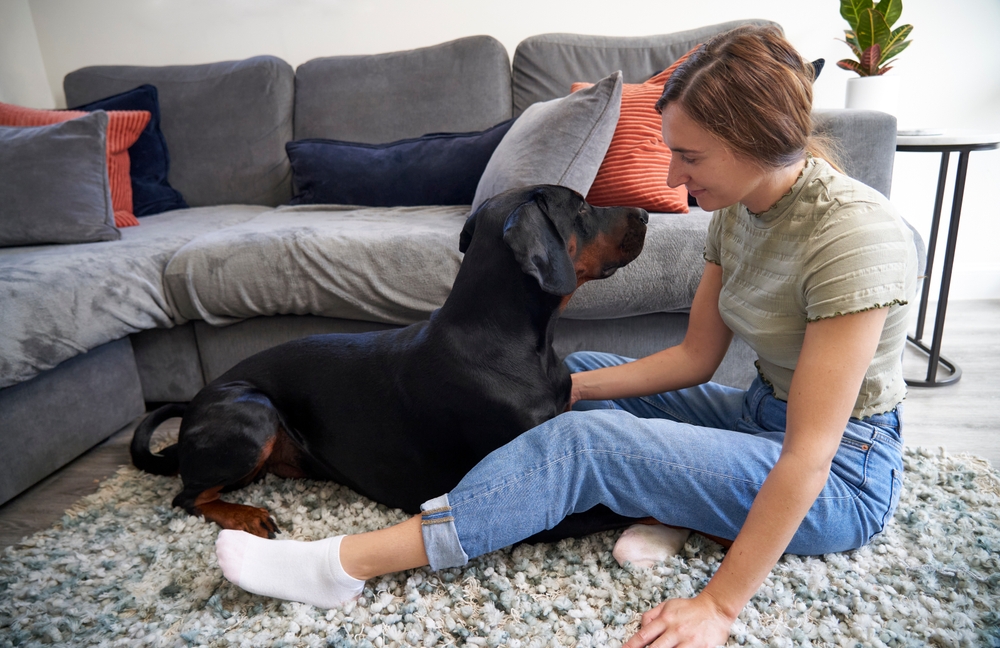In this article
We’re sorry to hear that you regret getting a dog, but we want you to know that you’re not alone. According to a 2022 Forbes survey, 54% of dog owners experience some regret in getting a dog.1 The reasons for your regret are totally valid and might include the added responsibilities, difficulty spending time away from home, costs, or behavioral issues. However, we do think there is a way forward with rehoming the dog being an absolute last resort. Hopefully, this article will help you find the experience of dog ownership rewarding rather than taxing.

How To Avoid Regret: 7 Things to Consider
While you can’t completely avoid regret after adopting a dog, we think having some realistic expectations about dog ownership will help you avoid disappointment. Whether you’re bringing home a puppy, or rescuing an older dog, there is an adjustment period before things settle into a comfortable routine.

1. Time Commitment
Dogs and puppies come with responsibilities that eat into your free time. You might experience symptoms of anxiety or depression after getting a new dog, something known as “puppy blues”. You may even experience interruptions to your sleep if your dog cries or needs to be taken to the toilet at night. You might feel your life needs to be organized around your dog, which to some extent is true. You are responsible for providing their needs including nutrition, exercise, grooming, and social interactions. Your old schedule may no longer work for you because of all these additional tasks.
We recommend trying to rearrange your schedule around your dog and getting into a new routine that includes their care. Your daily exercise and outings to dog-friendly venues can include your dog. If you have other people in your household try to delegate some responsibilities to them, so everyone is involved in caring for the dog and knows what they need to do. You have to provide a certain level of care to keep your dog happy and healthy. While it is hard work some see the experience as very rewarding. This could also be a time to get new, dog-friendly hobbies like hiking or dog sports.
2. Financial
According to a 2021 survey, 52% of people find their dog’s purchase and vet care more expensive than expected.2 Unexpected or chronic health problems can be challenging to manage and require some financial commitment. Pet insurance won’t cover pre-existing health complaints but can help with anything new that arises, depending on your level of coverage. We recommend considering pet insurance if the prospect of vet bills is keeping you up at night.
Other costs include food, toys, gear, professional grooming, training, and pet-sitting costs. There are some responsible ways to save by doing your own grooming, buying second-hand supplies, and asking family and friends for help. Cheaper end pet food is perfectly adequate for most dogs; as long as it meets American Association of Feed Control Officials (AAFCO) recommendations for your pet’s life stage, it will contain all the nutrients your pet needs and nothing dangerous.

3. Finding a Compatible Dog
In this case, the saying “hindsight is 20/20” may be accurate since you probably have already brought your dog home. Hopefully, whoever you brought the dog from helped ensure you were compatible with your dog. Responsible shelters should tell you about all known medical and behavioral issues and give guidance on how to look after your dog specifically. Ideally, you would have had a trial period to ensure your dog fits well into your home and ongoing support from the shelter. Similarly, responsible breeders would ensure that you are equipped to look after the breed and be aware of common issues. For example, if you are purchasing a high-energy working breed, you need free time to devote to their physical and mental exercise.
4. Understand Dog Behavior
The sad reality is that most animals who are returned to a shelter are surrendered due to behavioral issues. Puppies need continuous careful socialization and training to become well-adjusted adult dogs. They should ideally be exposed in a positive way to all of life’s experiences before the age of 14 weeks, within the “socialization period”. After this time they will be fearful of new experiences and need more work and training to accept them.
Older rescues are a mixed bag with some being very well trained and socialized and others having severe behavioral issues stemming from poor socialization and training, or traumatic experiences. Dogs with deep-seated issues do need a lot more help to overcome them.
Dogs have some wonderful personality traits like being loving and loyal. Unfortunately, they can go through some tricky phases like teething or fear periods when young and the dreaded adolescent phase.

5. Training
If you have little experience with dog training we recommend familiarizing yourself with non-aversive training techniques including desensitization, counter-conditioning, positive reinforcement, and negative punishment (the removal of something positive to deter bad behavior). Another thing about dogs is that they are always learning. The training is never “complete”, but occurs throughout life. At first, you might feel you can’t relax but eventually, you will adapt to this new way of life, and your dog will also become more and more well-behaved with correct training. You could reach out to a vet or professional trainer if you feel your training is not progressing as you expected.
If you need to speak with a vet but can't get to one, head over to PangoVet. It's our online service where you can talk to a vet online and get the advice you need for your pet — all at an affordable price!

6. Time
Good things take time and we believe that as time goes on you will learn more about your dog and they will learn about you, leading to a more comfortable relationship. Your puppy blues could last a few weeks to a few months, but they will get better with time. Statistics show that almost all dog returns occur within 4 months and a 2021 study showed that training becomes easier between 2 days and 4 months. Dogs’ fears also tended to decrease between 2 weeks and 4 months after being adopted.
The “333 rule” is well known among animal rescue organizations and refers to expected behavior in the first 3 days, 3 weeks, and 3 months after adoption. During the first 3 days, your new dog could be very nervous, and you need to give them space to acclimate, and not overstimulate them. Don’t take them on adventures or introduce them to your entire social circle. In the first 3 weeks, you can gradually introduce them to what life with you is like by introducing them to familiar places and people. Keep things positive and stay within their comfort zone. In the first 3 months, you can gradually increase their exposure and training. You can enroll in training glasses and cement a routine for them to get used to. Be patient with your dog and expect some setbacks. Keep things positive to build their confidence. With this in mind, most dogs fully adjust to their new routine in 3 months, but some may take longer.

7. Human Health Benefits
It may not feel like it for you right now, but many people report some wonderful benefits of dog ownership. Dogs provide a source of friendship and companionship, and many dog owners consider their dogs part of the family. Some people feel less lonely because of their dog and others feel a sense of purpose in caring for their pet. Exercising a dog gives you exercise and gets you out of the house. You may find yourself talking to people you wouldn’t normally because of conversations your dog has triggered. Some families connect over their dog’s care routine and training.

What to Do Before Rehoming
1. Bond With Your Dog
Reach out to your dog with patience and without any expectations of their behavior. Don’t let your dog run amok but set them up for success by placing them in a situation where they won’t misbehave. Spend some time bonding over treats or pats. If your dog is nervous, don’t force any interactions but rather wait at a distance until they show interest in interacting with you. Build some positive memories together to strengthen your bond.

2. Reach Out To Family and Friends
If you are struggling with dog ownership, share your struggles with family and friends. Some may have been in the same situation as you. They may even be able to help by looking after your dog for a few hours, or even a few days, to allow you to have a break from the responsibility.
3. Celebrate Small Wins
Make some small achievable goals to work towards. Dog behavior changes slowly over time so you might not remember how bad things used to be, or see how far you have come if you’re not looking for it. Give yourself and your dog credit for things moving in a positive direction.

4. Take a Break
Everyone needs time out from their responsibilities from time to time. Use trusted family, friends, pet-sitters, or boarding kennels to look after your dog while you get back on your feet. Enjoy some time to yourself knowing that your dog is in good hands.
5. Seek Professional Guidance
Whether you need to speak to a counselor about the challenges you are facing with your mental health or want veterinary insight about your dog’s behavior there are people out there that can help you. Veterinarians can prescribe behavioral medications for dogs if needed and behaviorists can help you implement training plans.


When to Consider Rehoming & 3 Steps to Prepare For It
There are some circumstances like unexpected illnesses or changes in circumstances, where you simply cannot keep your dog. If you are unable to provide the care that your dog needs, including social and training needs, then you may have to think about rehoming your dog. Your method of rehoming depends on your situation and whatever contracts you may have signed. If you have a contract from the breeder or shelter that requires you to return the dog to them in the event of rehoming, then this is what you have to do. Most shelters will allow you to return dogs if things haven’t worked out. If you don’t have the option to return your dog to where they came from, follow these important steps to responsibly rehome your dog.
1. Update Their Healthcare
The first step is going to the veterinarian for a check-up. Make sure their vaccinations are up to date, as well as preventatives. If they aren’t neutered, arrange for this to happen before you rehome them, as you don’t want your pet to be used for unscrupulous breeding. It’s a good idea to permanently identify your pet with a microchip, which will also allow you to change their ownership details, and help them get back to the right people if they ever get lost. If the costs of these interventions are too much, contact some local charities for help.
2. Rehome Through Responsible Avenues
The last thing you want is for your dog to end up in a bad situation with irresponsible or even unethical owners. You might know people in your social circles who would be a good fit to take on your dog, so you can ask them first. The benefit of this is that you may still be able to see your dog from time to time. Be wary of social media and other online platforms that let anyone see your pet. Local animal shelters and rescues are good to reach out to, and can often complete the vet work if you are unable to. If you rehome the dog yourself make sure the new home is a good fit and ask lots of questions before you let your dog go. Wherever your dog goes, you need to be upfront about their medical history, behavior, and temperament. This is for your dog’s sake to make sure they end up somewhere they can get what they need, but you also don’t want angry owners showing up down the track. You can give a written description of everything they need to know about your pet.
3. Prepare For the Transition
Put together all your dog’s belongings to send off with them. If they have any medication send this with them too. It’s a good idea to send the rest of their food, so if the owners need to change their diet they can do a gradual transition and prevent any stomach upsets. You should provide proof of vaccinations and neutering, as well as any pedigree certificate or other paperwork you might have. Transfer their ownership details on the microchip and local registries.


Conclusion
We hope that you have found this article helpful in reducing some of your stress. Even though we want you to have a fantastic bond with your dog, ownership is sometimes hard to navigate. There are some steps you should take, but ultimately the best situation is that the dog is with someone who loves and cares for them. If you don’t feel like you can do either of those things appropriately, you are doing the best thing by finding another arrangement for them.
Featured Image Credit: Javier Brosch, Shutterstock


















